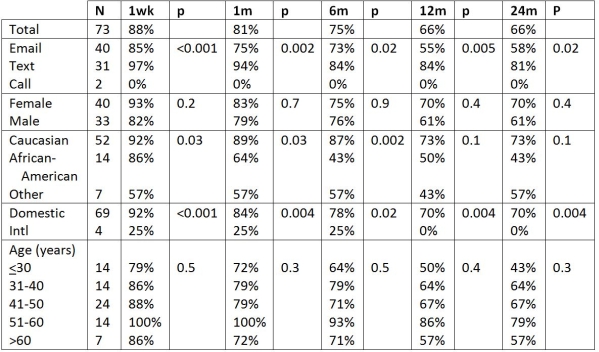Text Messaging Facilitates Follow-Up Communication with Live Donors.
Department of Surgery, Johns Hopkins University School of Medicine, Baltimore, MD.
Meeting: 2016 American Transplant Congress
Abstract number: C154
Keywords: Donation, Kidney transplantation
Session Information
Session Name: Poster Session C: Kidney Donor Evaluation and Donor Nephrectomy
Session Type: Poster Session
Date: Monday, June 13, 2016
Session Time: 6:00pm-7:00pm
 Presentation Time: 6:00pm-7:00pm
Presentation Time: 6:00pm-7:00pm
Location: Halls C&D
Close live kidney donor follow-up requires new methods of communicating with donors. Text messaging offers a low-cost method of contacting live organ donors and may improve follow-up rates.
METHODS: Live kidney donors (LKD) at a single institution were recruited from May 2010 to June 2011. LKD selected their preferred method of communication: telephone call, e-mail, or text message. LKD were contacted following their surgery at 1 week, 1 month, 6 months, 12 months, and 24 months. Chi-squared testing was used to compare rates of response between groups.
RESULTS: Seventy-one LKD were recruited for the study. The response rate at 1 week post-operation was 89% and decreased at each time point before stabilizing between 12 and 24 months at 66%. Response rates were higher when the method of contact was text message (97% at 1wk, 94% at 1m, 84% at 6m and 12m, 81% at 24m) versus e-mail (85% at 1wk, 75% at 1m, 73% at 6m, 55% at 12m, 58% at 24m) or telephone call (0% at all time points, p<0.02 at all time points). Female LKD had a higher response rate (93% at 1wk, 83% at 1m, 75% at 6m, 70% at 12m and 24m) than male LKD (82% at 1wk, 79% at 1m, 76% at 6m, 61% at 12m and 24m), but this difference was not statistically significant. By race, Caucasian LKD were most likely to respond (92% at 1wk, 89% at 1m, 87% at 6m, 73% at 12m and 24m), followed by African-American LKD (86% at 1wk, 64% at 1m, 43% at 6m, 50% at 12m, 43% at 24m; p=0.03 at 1wk, 0.03 at 1m, 0.002 at 6m, 0.1 at 12m, 0.1 at 24m). There was a trend toward higher response rates in older LKD, particularly those 51-60 years old (100% at 1wk and 1m, 93% at 6m, 86% at 12m, 79% at 24m), but the differences in response rates between age groups were not statistically significant.
Table 1. Follow-up response rates for various categories of LKD

CONCLUSION: Text messaging is superior to e-mail and telephone as a method of contacting LKD following their operations. Notably, most LKD prefer texting and email over a telephone call for follow-up. Differences in response rate between races varied over the follow-up period. There were no statistically significant differences in response rates between genders.
CITATION INFORMATION: Moore J, Massie A, Berger J, Montgomery J, Dorry S. Text Messaging Facilitates Follow-Up Communication with Live Donors. Am J Transplant. 2016;16 (suppl 3).
To cite this abstract in AMA style:
Moore J, Massie A, Berger J, Montgomery J, Dorry S. Text Messaging Facilitates Follow-Up Communication with Live Donors. [abstract]. Am J Transplant. 2016; 16 (suppl 3). https://atcmeetingabstracts.com/abstract/text-messaging-facilitates-follow-up-communication-with-live-donors/. Accessed December 14, 2025.« Back to 2016 American Transplant Congress
